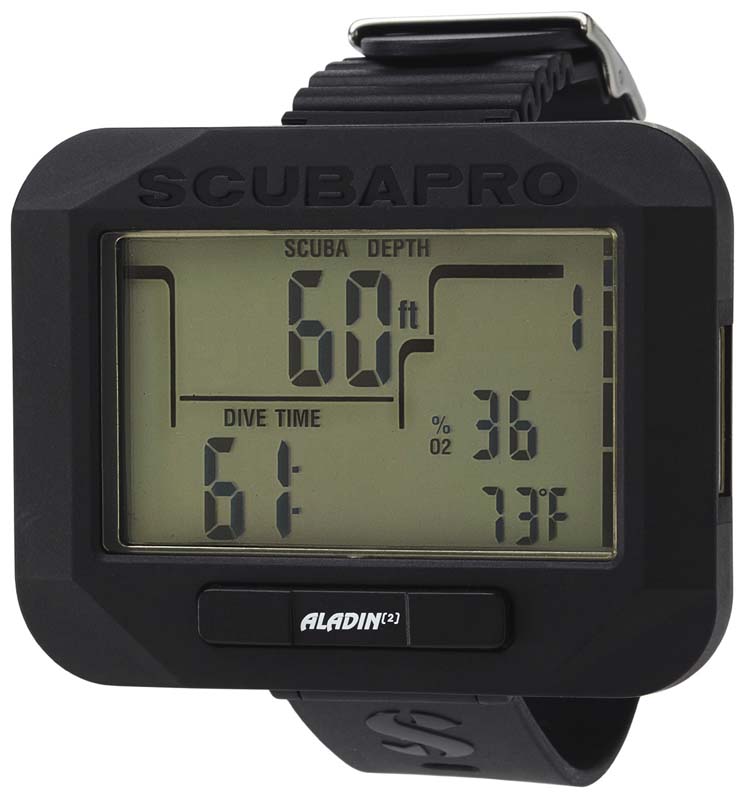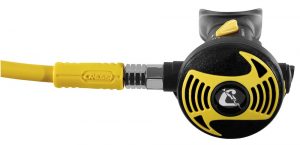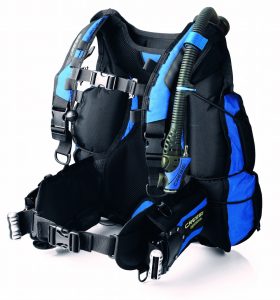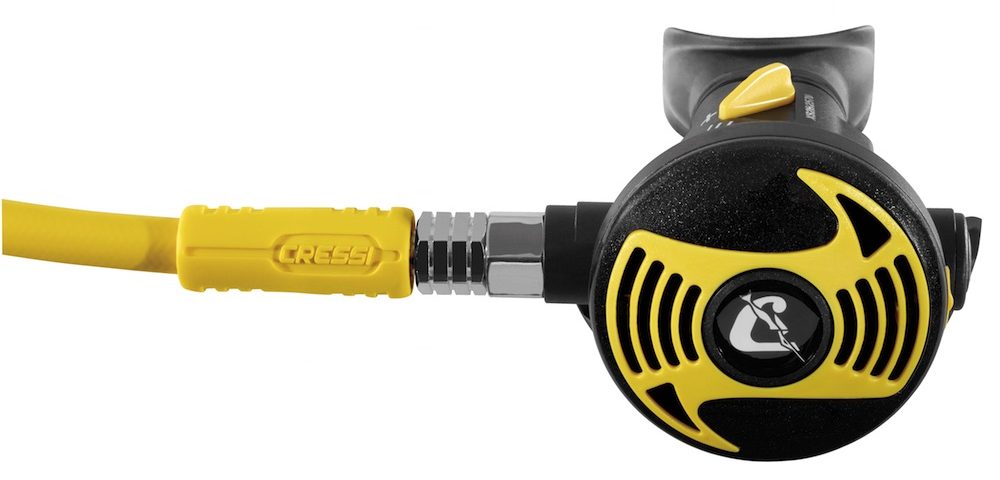
Johnson Outdoors Diving Recalls Dive Computers Due to Injury Hazard
February 13, 2016The post, “Servicing Your Gear and Why It’s Important” originally appeared in Scuba Diver Life. Written by Dillon, a cold-water trained PADI Master Scuba Diver Trainer.
Regulator Service

Cressi Octopus Regulator one of the many brands serviced by ScubaTechs
Let’s start this topic off with the first thing that should always be imprinted into your mind, not only when you take your regulator in for service, but when you pack it away under your dive gear, store it for an extended period of time or wonder if your regulator is overdue for service. This is your life support system! It is of the same importance as the systems on a space shuttle, it is delivering oxygen rich air to your lungs to control your body’s functions, and we all know what happens without it.
By far this is the MOST important piece of equipment that you own, as reasoned in the above paragraph so we must take care of it accordingly. Your regulator should be serviced annually (with some brands 2 years, and we will talk about this shortly) no matter if you have 1 dive or 100 dives. Why? Because your regulator is built of many moving parts, especially o-rings which are made of either Rubber and on most or all newer regulators it will be EPDM (Oxygen Compatible to 40%). After a year the integrity of the o-rings start to diminish and the lubricants start to wear down and become stale. So it’s not a matter of “Oh but I only dove with it 4 times so I can service it in another year”, it’s a time issue. Just like the oil in your car, only good for 3 – 4 months, you wouldn’t think twice about changing the oil in your summer sports car. So which one is more important to you? And why would you want to cut corners in this case.
Taking your regulator in for annual service is not as expensive as you may think, 100 – 200 dollars a year and cheaper with some equipment manufacturers covering the parts for you. Some brands say that you need to service your regulator every two years. I would strongly (emphasis on the strong) advice that you use the following to determine when you take your regulator to your local dive shop. Consider the following:
- Service your Regulator Annually if you do 1 – 50 dives a year; which is typical of a vacation diver
- If you are what the SCUBA industry labels as an “active diver” you do 50 – 100 dives a year, and in this case you should service your regulator annually and definitely do not wait two years.
- Are you in the 100 + range? If so way to go! You should be proud to call yourself a dive-a-holic or dive addict. Get your regulator serviced at least two times a year if you can afford it.
Personally, I teach and dive for my own leisure, so not only do I rely on my gear, so do my students and buddies, and therefore I get mine serviced every 6 – 12 months at the least. Some manufacturers cover you for parts under your warranties every 6 months, wait until you read down to the warranty section of my feature and I will elaborate for you!
Tank Service and Gas Fills
 So everyone should have learnt in their respective beginner dive courses a little bit about scuba tanks. If so you should know that there are two types of tanks, Steel and Aluminums. Also that these tanks should receive a visual inspection every year and a hydro static inspection every 3-5 years depending which country you live in (North America is 5 years). There are also a few types of pressures for steel tanks, where as aluminums are to a max of 3000 and some HP Aluminums to 3300 PSI (200 Bar to 220 Bar). Steels have three types of pressure ratings, Low Pressure (2400 PSI/160 Bar), Pressure (3000PSI/200Bar), and High Pressure (3400PSI/230Bar) which are most popular. In respect to buoyancy of aluminums and steels, an aluminum 80 tank will make you positively buoyant about 6 pounds or 3kgs at the end of your dive, whereas a steel 100 will stay negative 6 pounds and remain neutral when empty. I am going to try and keep this as plain and simple as possible so that every level of reader can enjoy this equally.
So everyone should have learnt in their respective beginner dive courses a little bit about scuba tanks. If so you should know that there are two types of tanks, Steel and Aluminums. Also that these tanks should receive a visual inspection every year and a hydro static inspection every 3-5 years depending which country you live in (North America is 5 years). There are also a few types of pressures for steel tanks, where as aluminums are to a max of 3000 and some HP Aluminums to 3300 PSI (200 Bar to 220 Bar). Steels have three types of pressure ratings, Low Pressure (2400 PSI/160 Bar), Pressure (3000PSI/200Bar), and High Pressure (3400PSI/230Bar) which are most popular. In respect to buoyancy of aluminums and steels, an aluminum 80 tank will make you positively buoyant about 6 pounds or 3kgs at the end of your dive, whereas a steel 100 will stay negative 6 pounds and remain neutral when empty. I am going to try and keep this as plain and simple as possible so that every level of reader can enjoy this equally.
Let’s start with aluminums and what you should know for servicing them. Aluminum tanks are tough, because they have such thick walls but they do not handle impact very well and with older tanks are especially prone to cracks, bursts and dents in the metal. Service of your aluminum tank should mean simply that you are being careful when moving the tank or transporting it, keeping an up to date visual inspection (visuals) and making sure that you take it to a reputable fill station as to keep out contaminates which could cause interior corrosion. The type of corrosion that would be commonly found in an aluminum tank is aluminum oxide, caused by moisture build up from an improperly maintained compressor or letting your tank run out of air ( this is a mandatory visual inspection from any dive shop and for your own safety you should recommend it). Also Valve service is very important and is recommended by tank manufactures annually, a note on this is that you can either get a valve rebuild or a valve clean. Some dive operations will simply clean and replace o-rings, where as others will replace the valve inner workings, which I personally recommend as to avoid catastrophic failure.
Steel tanks have mostly the same service requirements that aluminums do, such as keeping care during transport, up to date visual inspections and getting the valve serviced. In regards to corrosion of the inner tank, what we (the visual inspector) would commonly come across is a bit of rust. If you have experienced your dive shop saying “we tumbled your tank” this doesn’t mean they pushed it down the drive way, or tried to see how many times they could make it flip when throwing it. It means that they filled the tank with a composite that takes a small layer off, rinsed it, and dried it to like new conditions. Just like coating your skis with a fresh layer of wax. This is a result of fast fills, which can be avoided by taking it again to a reputable dive outfit. The last consideration for care of YOUR steel tank is that you should give the dive shop adequate time to fill your tank. There is something called a hot fill, which is when the tank is filled to 10 percent it’s working pressure (LP/P/HP remember!) which would increase the heat of the metal causing it to expand and contract when cooling. This is bad for your tank and WILL reduce the life of your tank. So don’t blame the dive shop for fast or hot fills, it’s up to your time restraints.
One of the only complaints I get, besides customers jealous of my stunning good looks, is that “You Failed my tank so you could sell me a new one!” You have every right to think that, and I can’t speak for other dive shops, but I can speak for my own when I say, we like to walk on our own two legs. There could be many reasons that your tank failed visual inspection, but most commonly there are cracks in the tank threads (more than three to be exact). This would cause a failure that would severely injure the tank filler if it were to fail. Another reason may be that your tank is old dude! The maximum life expectancy for an aluminum tank is 25 years old and 30 years for steel. So we are not looking to make money, we just want to ensure the safety of ourselves and co-industry workers by getting a sketchy tank off the market.
Gas fills are simple: Reputable dive shop, maintained compressor, and visually inspected tanks. In North America most dive shops should have their air tested quarterly to grade “E” standard and filters changed every 100-200 hours to a maximum of 6 months, YOU SHOULD NOT be afraid to ask the shop owner these questions and if they can’t answer, go elsewhere. With enriched air or custom fills over 40 percent you are required to have your tank oxygen serviced, this includes cleaning of the valve and inner tank to avoid an oxygen explosion which could potentially level the dive store to rubble.
BCD Service

Cressi Air Travel BCD
Just like any piece of your gear, the BCD is very important and a failure would be cause to end your dive or possibly put yourself at harm. So what consists of a BCD Service? Well you have the major parts of your BCD that you need to consider: the inflator, the bladder and the dump valves. All of these require attention, some annually and some are after every dive. You are responsible for checking the function of your BCD and for bringing it in for service when needed. I would recommend checking the following for proper operation before and after every dive:
- Your inflator is adding and releasing air on press of the inflator and deflator buttons and is not slowly leaking or “auto-filling” your bladder.
- The washers that keep your dump valves and inflator are hand tight and not loose.
- Your BCD holds air over night when fully inflated
- Your BCD’s dump valves are free of debris to avoid an overfilling or dumping problem during your dive.
When you bring your Regulators in for service, bring in your BCD, you can’t go diving without your regulator so you might as well have your BCD’s inflator valve serviced and valves cleaned, it will cost you 40 dollars at the very most and is well worth it to avoid failure. What we do is take your inflator off, inspect the body for any cracks and replace the inner workings with a special kit from the manufacturer.
If you have questions about your scuba equipment, please feel free to contact us.
Currently only servicing in the U.S.



